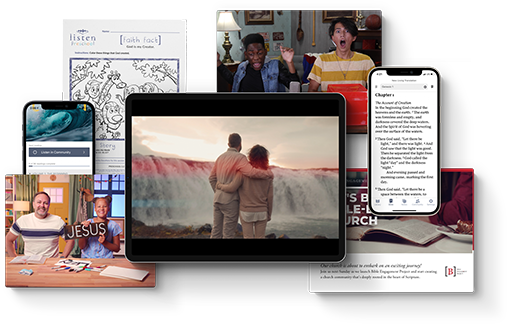Gender and the Image of God
By Linda Seiler, Ph.D. and Renée Griffith Grantham | Posted In What Does the Bible Say
The Church’s conversations on gender often focus on either the place of women in leadership or on taking a stance on homosexuality, yet both of these are secondary issues reflecting people’s underlying beliefs about gender. The primary issue is an understanding or misunderstanding of the Bible’s view on gender—which starts in the Garden of Eden.
IMAGO DEI
The Bible opens with accounts of how God created the heavens and the earth (Genesis 1:1 to 2:3; 2:4–25), and the only creatures made “in the image of God” were humans, male and female: “So God created human beings in his own image. In the image of God he created them; male and female he created them” (1:27, NLT). But what does “in his image” mean?
The image of God refers to the ways in which humans are set apart from all the rest of creation (Heard the term imago Dei? That’s the popular Latin phrase for this concept). God, in making humans, imparted something of himself into every one of us. Unlike inheriting physical traits from parents, the image of God gives people inner characteristics that reflect God’s nature—things like creative activity, emotional and intellectual capacities, leadership skills, and relational qualities.
God created sea creatures and birds “according to their kinds” (Genesis 1:21, NIV) and land creatures “according to their kinds” (1:25, NIV), but He made humans according to His kind, Unlike animals, humans were given a measure of power: they were told to govern the earth and reign over the creatures in the sea, sky, and on land (1:28). God called all of this “very good” (1:31, NIV).
Within the Christian worldview, all people are to be treated with respect and honor because they bear the image of God. Starting with the image of God begs the question, What is God like? Dr. Linda Seiler shares three characteristics of God that we can bring up when speaking to others about a biblical understanding of gender.
A POSTMODERN, POST-CHRISTIAN WORLDVIEW ON GENDER
Linda Seiler, Ph.D., is board chair for ReStory Ministries and a national Chi Alpha field specialist in Applied Theology and Culture. Through her years with Chi Alpha Campus Ministries, she has engaged with increasing numbers of college students who are postmodern and post-Christian—meaning that they have a general, widespread distrust toward absolute truth claims or any belief system that claims to be exclusive. They don’t believe that Christianity contains ultimate answers to life’s questions. When it comes to gender, postmodern, post-Christian students don’t buy what the Bible has to say about sexual sins because the Bible is, to them, simply one of several life manuals that are equally meaningful—and meaningless.
These thought processes are not confined to college students but instead permeate Western secular culture at every age level. Seiler shares how she approaches topics of gender and sexuality with college students: she begins with God’s nature. Beginning with relationship rather than theological premises opens up conversations that can lead to transformation.
Going back to imago Dei or the image of God, Seiler sees three aspects of God’s image or nature in Genesis 1–2 that she uses as bridges for conversation:
- First, God is creative. (Genesis 1:26–27) These verses speak of God’s creation of humanity—the beings endowed with the capacity and calling to reign over the rest of creation on land, sea, and sky.
- Second, God is relational. (Genesis 2:18) This verse speaks to God’s desire for His creation to not be alone, so He created an equal and opposite companion, just as He did for the birds, fish, and animals.
- Third, God is both unified and diverse. (Genesis 1:26). The pronouns in “Let us make human beings in our image, to be like us” (emphasis added) very possibly indicates communication between the unified Persons of the godhead.
Throughout Scripture, God reveals the connection between himself as Father, Jesus as Son, and His Holy Spirit, and we express this connection today with the term Trinity. The point Seiler makes is that God, one Being of three persons, exists in complete harmony. He expresses diversity through Personhood while still being completely unified as one Being.
Because humans are made in the image of a creative, relational, unified-in-diversity God, we are therefore:
- Procreative, called to exercise dominion over the earth, to create from the earth’s raw materials, and to multiply;
- Relational, called to live in community; and
- Unified in diversity: unified in being humans and diverse in biological sex.
THE PURPOSE OF IMAGO DEI
Our procreative, relational, unified-in-diversity purposes aren’t simply for one another: we are endowed with these markers of God’s image so that we can commune with God himself. Christian history as outlined in Scripture tells us that the goal of existence is to be united with Jesus, and He uses the husband-wife marriage as an illustration. The union of this relationship “is a great mystery, but it is an illustration of the way Christ and the church are one” (Ephesians 5:32). Specifically, this unity-in-diversity comes in spirit, as 1 Corinthians 6:17 points out: “But the person who is joined to the Lord is one spirit with him.” This relationship, while unified and relational, is also procreative in the sense that when we enter into relationship with Christ, we become a new creation: “The old life is gone; a new life has begun!” (2 Corinthians 5:17).
Starting a conversation about gender with the image of God is not a roundabout way to approach a sensitive topic. It’s a starting point that gets to the heart of the issue: we are created on purpose for a purpose. Regardless of our gender, our Creator has imprinted himself into each of us.
Next time a gender-related topic comes your way, ask yourself these questions:
- Does the person know that he or she is created in the image of God?
- Does the person know what “image of God” means?
- Does the person know that God is procreative, relational, and unified in diversity?
- Does the person know what these characteristics mean for humanity?
This is a starting point, not a discussion-ender. But bringing gendered conversations to this truth allows for the narrative of Scripture to be woven into conversation and can lead people to greater purpose and more hope.
* * *
To read more from Linda, click here for her website, here for another article she wrote about the image of God, and here for the ReStory Ministries website.


